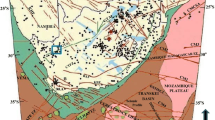Abstract
THE Great Glen Fault was shown by W. Q. Kennedy1 to be a sinistral tear fault on which a displacement of about 65 miles has occurred since Middle Old Red Sandstone time. E. M. Anderson1 considered that “the curvature of the fault trace may indicate that we are dealing with the south-western sector of a major fault and that the main extension of the dislocation will probably lie to the north-east”. This curvature is a gradual change of strike from about 040° in Loch Linnhe to about 035° at Inverness.
Similar content being viewed by others
References
Kennedy, W. Q., Quart. J. Geol. Soc. Lond., 102, 41 (1946).
British Admiralty Charts, 1118b, 1119, 2182c, 2339, 3057, 115.
Finlay, T. M., Trans. Roy. Soc. Edin., 56, 671 (1930).
Summaries Prog. Geol. Surv. Great Britain for 1932, Pt. 1, 77 (1933).
Flinn, D., Quart. J. Geol. Soc. Lond., 110, 177 (1954).
Author information
Authors and Affiliations
Rights and permissions
About this article
Cite this article
FLINN, D. Continuation of the Great Glen Fault beyond the Moray Firth. Nature 191, 589–591 (1961). https://doi.org/10.1038/191589b0
Issue Date:
DOI: https://doi.org/10.1038/191589b0
- Springer Nature Limited





